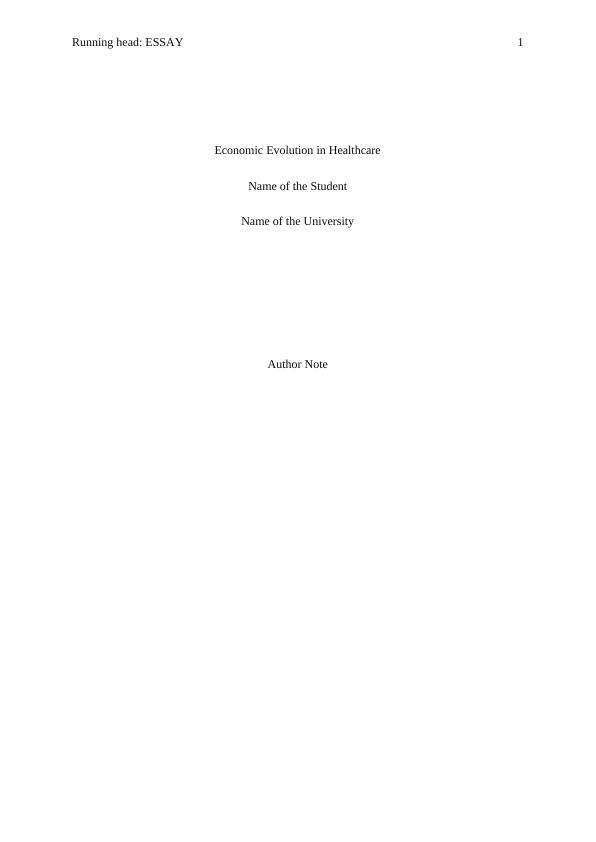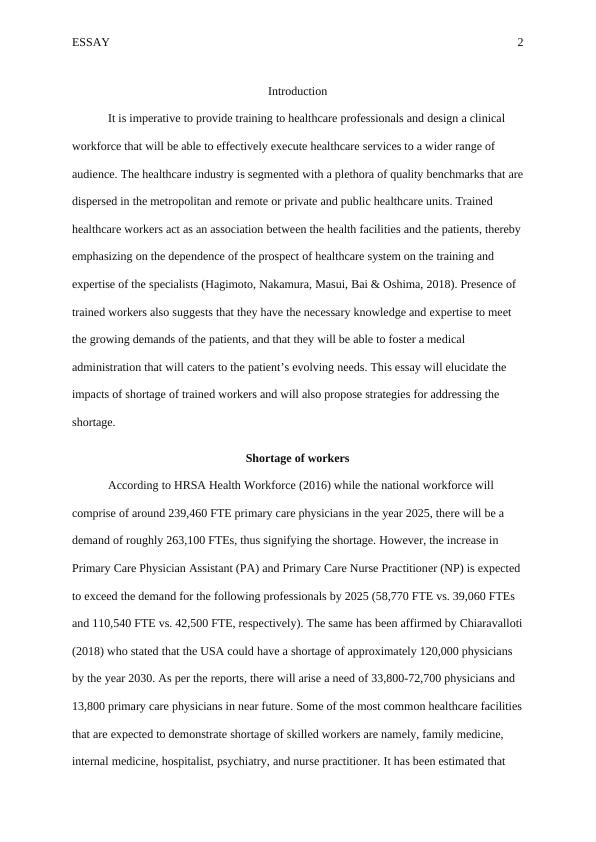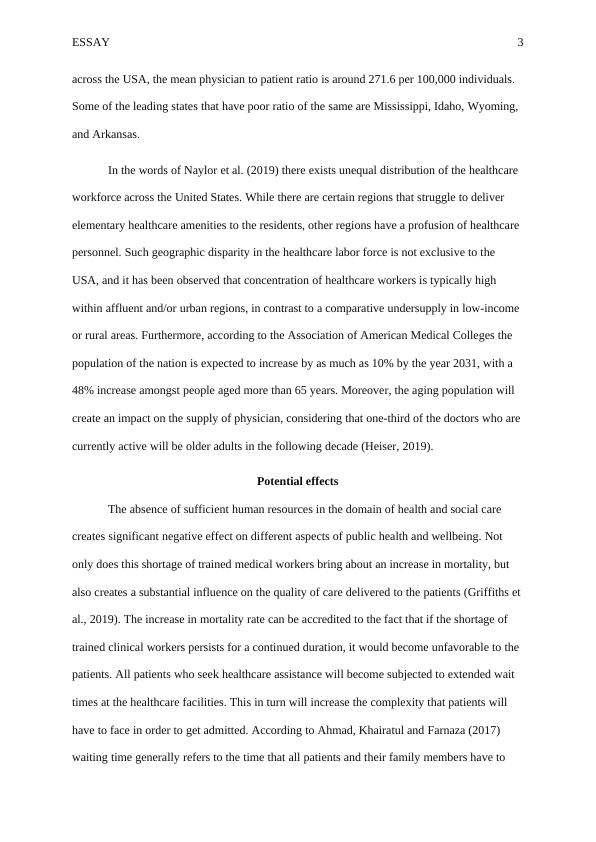Economic Evolution in Healthcare
Added on 2022-08-18
9 Pages2438 Words23 Views
Running head: ESSAY 1
Economic Evolution in Healthcare
Name of the Student
Name of the University
Author Note
Economic Evolution in Healthcare
Name of the Student
Name of the University
Author Note

ESSAY 2
Introduction
It is imperative to provide training to healthcare professionals and design a clinical
workforce that will be able to effectively execute healthcare services to a wider range of
audience. The healthcare industry is segmented with a plethora of quality benchmarks that are
dispersed in the metropolitan and remote or private and public healthcare units. Trained
healthcare workers act as an association between the health facilities and the patients, thereby
emphasizing on the dependence of the prospect of healthcare system on the training and
expertise of the specialists (Hagimoto, Nakamura, Masui, Bai & Oshima, 2018). Presence of
trained workers also suggests that they have the necessary knowledge and expertise to meet
the growing demands of the patients, and that they will be able to foster a medical
administration that will caters to the patient’s evolving needs. This essay will elucidate the
impacts of shortage of trained workers and will also propose strategies for addressing the
shortage.
Shortage of workers
According to HRSA Health Workforce (2016) while the national workforce will
comprise of around 239,460 FTE primary care physicians in the year 2025, there will be a
demand of roughly 263,100 FTEs, thus signifying the shortage. However, the increase in
Primary Care Physician Assistant (PA) and Primary Care Nurse Practitioner (NP) is expected
to exceed the demand for the following professionals by 2025 (58,770 FTE vs. 39,060 FTEs
and 110,540 FTE vs. 42,500 FTE, respectively). The same has been affirmed by Chiaravalloti
(2018) who stated that the USA could have a shortage of approximately 120,000 physicians
by the year 2030. As per the reports, there will arise a need of 33,800-72,700 physicians and
13,800 primary care physicians in near future. Some of the most common healthcare facilities
that are expected to demonstrate shortage of skilled workers are namely, family medicine,
internal medicine, hospitalist, psychiatry, and nurse practitioner. It has been estimated that
Introduction
It is imperative to provide training to healthcare professionals and design a clinical
workforce that will be able to effectively execute healthcare services to a wider range of
audience. The healthcare industry is segmented with a plethora of quality benchmarks that are
dispersed in the metropolitan and remote or private and public healthcare units. Trained
healthcare workers act as an association between the health facilities and the patients, thereby
emphasizing on the dependence of the prospect of healthcare system on the training and
expertise of the specialists (Hagimoto, Nakamura, Masui, Bai & Oshima, 2018). Presence of
trained workers also suggests that they have the necessary knowledge and expertise to meet
the growing demands of the patients, and that they will be able to foster a medical
administration that will caters to the patient’s evolving needs. This essay will elucidate the
impacts of shortage of trained workers and will also propose strategies for addressing the
shortage.
Shortage of workers
According to HRSA Health Workforce (2016) while the national workforce will
comprise of around 239,460 FTE primary care physicians in the year 2025, there will be a
demand of roughly 263,100 FTEs, thus signifying the shortage. However, the increase in
Primary Care Physician Assistant (PA) and Primary Care Nurse Practitioner (NP) is expected
to exceed the demand for the following professionals by 2025 (58,770 FTE vs. 39,060 FTEs
and 110,540 FTE vs. 42,500 FTE, respectively). The same has been affirmed by Chiaravalloti
(2018) who stated that the USA could have a shortage of approximately 120,000 physicians
by the year 2030. As per the reports, there will arise a need of 33,800-72,700 physicians and
13,800 primary care physicians in near future. Some of the most common healthcare facilities
that are expected to demonstrate shortage of skilled workers are namely, family medicine,
internal medicine, hospitalist, psychiatry, and nurse practitioner. It has been estimated that

ESSAY 3
across the USA, the mean physician to patient ratio is around 271.6 per 100,000 individuals.
Some of the leading states that have poor ratio of the same are Mississippi, Idaho, Wyoming,
and Arkansas.
In the words of Naylor et al. (2019) there exists unequal distribution of the healthcare
workforce across the United States. While there are certain regions that struggle to deliver
elementary healthcare amenities to the residents, other regions have a profusion of healthcare
personnel. Such geographic disparity in the healthcare labor force is not exclusive to the
USA, and it has been observed that concentration of healthcare workers is typically high
within affluent and/or urban regions, in contrast to a comparative undersupply in low-income
or rural areas. Furthermore, according to the Association of American Medical Colleges the
population of the nation is expected to increase by as much as 10% by the year 2031, with a
48% increase amongst people aged more than 65 years. Moreover, the aging population will
create an impact on the supply of physician, considering that one-third of the doctors who are
currently active will be older adults in the following decade (Heiser, 2019).
Potential effects
The absence of sufficient human resources in the domain of health and social care
creates significant negative effect on different aspects of public health and wellbeing. Not
only does this shortage of trained medical workers bring about an increase in mortality, but
also creates a substantial influence on the quality of care delivered to the patients (Griffiths et
al., 2019). The increase in mortality rate can be accredited to the fact that if the shortage of
trained clinical workers persists for a continued duration, it would become unfavorable to the
patients. All patients who seek healthcare assistance will become subjected to extended wait
times at the healthcare facilities. This in turn will increase the complexity that patients will
have to face in order to get admitted. According to Ahmad, Khairatul and Farnaza (2017)
waiting time generally refers to the time that all patients and their family members have to
across the USA, the mean physician to patient ratio is around 271.6 per 100,000 individuals.
Some of the leading states that have poor ratio of the same are Mississippi, Idaho, Wyoming,
and Arkansas.
In the words of Naylor et al. (2019) there exists unequal distribution of the healthcare
workforce across the United States. While there are certain regions that struggle to deliver
elementary healthcare amenities to the residents, other regions have a profusion of healthcare
personnel. Such geographic disparity in the healthcare labor force is not exclusive to the
USA, and it has been observed that concentration of healthcare workers is typically high
within affluent and/or urban regions, in contrast to a comparative undersupply in low-income
or rural areas. Furthermore, according to the Association of American Medical Colleges the
population of the nation is expected to increase by as much as 10% by the year 2031, with a
48% increase amongst people aged more than 65 years. Moreover, the aging population will
create an impact on the supply of physician, considering that one-third of the doctors who are
currently active will be older adults in the following decade (Heiser, 2019).
Potential effects
The absence of sufficient human resources in the domain of health and social care
creates significant negative effect on different aspects of public health and wellbeing. Not
only does this shortage of trained medical workers bring about an increase in mortality, but
also creates a substantial influence on the quality of care delivered to the patients (Griffiths et
al., 2019). The increase in mortality rate can be accredited to the fact that if the shortage of
trained clinical workers persists for a continued duration, it would become unfavorable to the
patients. All patients who seek healthcare assistance will become subjected to extended wait
times at the healthcare facilities. This in turn will increase the complexity that patients will
have to face in order to get admitted. According to Ahmad, Khairatul and Farnaza (2017)
waiting time generally refers to the time that all patients and their family members have to

End of preview
Want to access all the pages? Upload your documents or become a member.
Related Documents
Entrepreneurship in Advanced Nursing Practionerlg...
|28
|2058
|18
A shortage of nurses in the overcrowding emergency departmentlg...
|6
|1079
|323
Family Nurse Practioner Assesment Analysislg...
|5
|993
|21
Introducing the Advanced Nurse Practitioner Primarylg...
|10
|3079
|16
Issues Affecting Nurse Practitioners: Prescribing Authoritylg...
|15
|3819
|335
Nursing Leadership: Addressing Staff Shortages and Layoffs in Healthcarelg...
|5
|1247
|161
